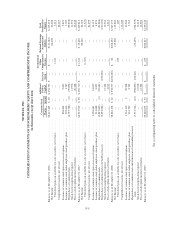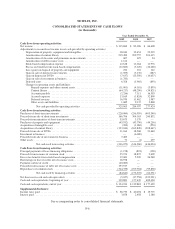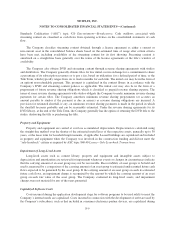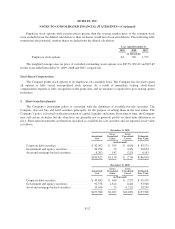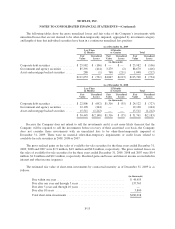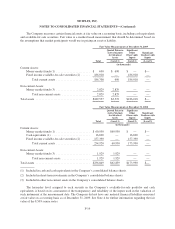NetFlix 2009 Annual Report Download - page 62
Download and view the complete annual report
Please find page 62 of the 2009 NetFlix annual report below. You can navigate through the pages in the report by either clicking on the pages listed below, or by using the keyword search tool below to find specific information within the annual report.NETFLIX, INC.
NOTES TO CONSOLIDATED FINANCIAL STATEMENTS—(Continued)
Standards Codification (“ASC”) topic 920 Entertainment—Broadcasters. Cash outflows associated with
streaming content are classified as cash flows from operating activities on the consolidated statements of cash
flow.
The Company classifies streaming content obtained through a license agreement as either a current or
non-current asset in the consolidated balance sheets based on the estimated time of usage after certain criteria
have been met, including availability of the streaming content for its first showing. Streaming content is
amortized on a straight-line basis generally over the terms of the license agreements or the title’s window of
availability.
The Company also obtains DVD and streaming content through revenue sharing agreements with studios
and distributors. The Company generally obtains titles for low initial cost in exchange for a commitment to share
a percentage of its subscription revenues or to pay a fee, based on utilization, for a defined period of time, or the
Title Term, which typically ranges from six to twelve months for each title. The initial cost may be in the form of
an upfront non-refundable payment. This payment is capitalized in the content library in accordance with the
Company’s DVD and streaming content policies as applicable. The initial cost may also be in the form of a
prepayment of future revenue sharing obligations which is classified as prepaid revenue sharing expense. The
terms of some revenue sharing agreements with studios obligate the Company to make minimum revenue sharing
payments for certain titles. The Company amortizes minimum revenue sharing prepayments (or accretes an
amount payable to studios if the payment is due in arrears) as revenue sharing obligations are incurred. A
provision for estimated shortfall, if any, on minimum revenue sharing payments is made in the period in which
the shortfall becomes probable and can be reasonably estimated. Under the revenue sharing agreements for its
DVD library, at the end of the Title Term, the Company generally has the option of returning the DVD title to the
studio, destroying the title or purchasing the title.
Property and Equipment
Property and equipment are carried at cost less accumulated depreciation. Depreciation is calculated using
the straight-line method over the shorter of the estimated useful lives of the respective assets, generally up to 30
years, or the lease term for leasehold improvements, if applicable. Leased buildings are capitalized and included
in property and equipment when the Company was involved in the construction funding and did not meet the
“sale-leaseback” criteria as required by ASC topic 840.40 Leases—Sale-Leaseback Transactions.
Impairment of Long-Lived Assets
Long-lived assets such as content library, property and equipment and intangible assets subject to
depreciation and amortization are reviewed for impairment whenever events or changes in circumstances indicate
that the carrying amount of an asset group may not be recoverable. Recoverability of asset groups to be held and
used is measured by a comparison of the carrying amount of an asset group to estimated undiscounted future cash
flows expected to be generated by the asset group. If the carrying amount of an asset group exceeds its estimated
future cash flows, an impairment charge is recognized by the amount by which the carrying amount of an asset
group exceeds fair value of the asset group. The Company evaluated its long-lived assets, and impairment
charges were not material for any of the years presented.
Capitalized Software Costs
Costs incurred during the application development stage for software programs to be used solely to meet the
Company’s internal needs are capitalized. Costs incurred in connection with the development of software used by
the Company’s subscribers, such as that included in consumer electronics partner devices, are capitalized during
F-9








